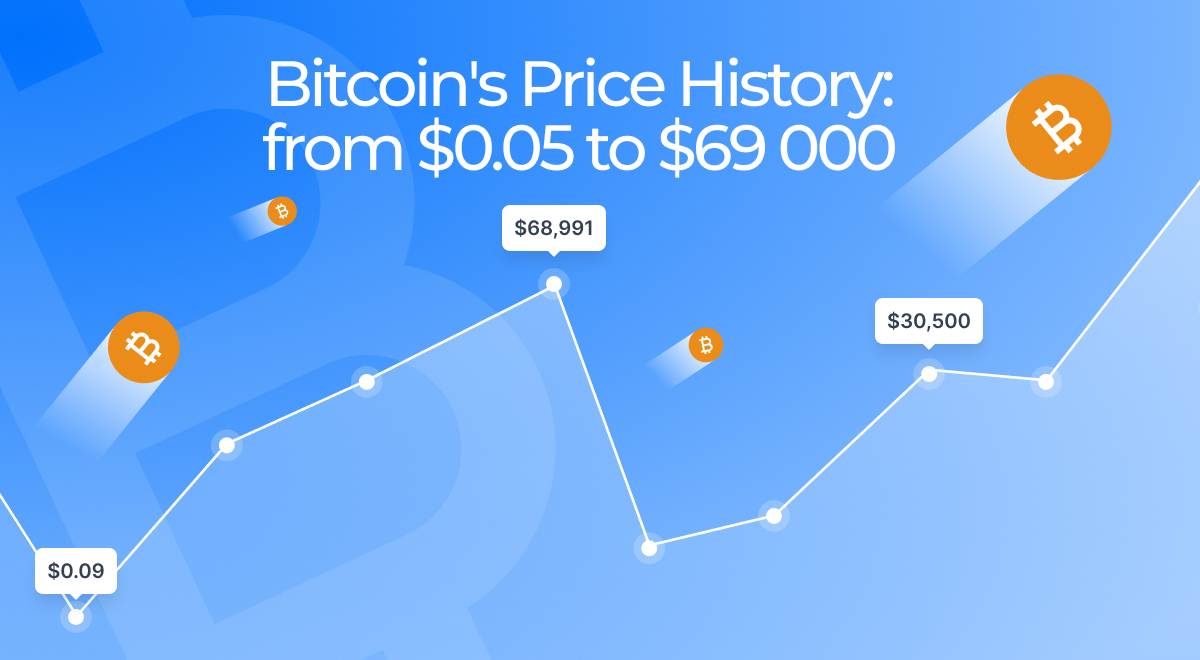Bitcoin’s Price History: from $0.05 to $69 000

Introduction
Bitcoin is the world’s first decentralized digital currency, created in 2009 by an anonymous individual or group using the pseudonym Satoshi Nakamoto. It quickly gained popularity among tech enthusiasts and libertarians, who saw it as a way to bypass traditional financial institutions and create a decentralized, peer-to-peer payment system. Since then, Bitcoin has become one of the most well-known and highly valued cryptocurrencies in the world, with a fascinating price history that has captivated the attention of investors and analysts alike. In this article, we’ll explore Bitcoin’s price history and delve into the world of cryptocurrency, including the best crypto to mine, what a crypto wallet is, and more.
The Early Days
Bitcoin was first introduced in 2009. At the time, the price of Bitcoin was virtually zero, with the first recorded transaction valuing Bitcoin at just $0.003. The currency quickly gained popularity among tech enthusiasts and libertarians, who saw it as a way to bypass traditional financial institutions and create a decentralized, peer-to-peer payment system.
In the years that followed, the price of Bitcoin slowly increased, reaching $1 by 2011. However, it wasn’t until 2013 that Bitcoin experienced its first major price surge, with the currency rising from around $13 in January to over $1,000 by December of that year. The price surge was largely attributed to increased media attention and growing adoption of Bitcoin by merchants and consumers.
The First Correction
The rapid rise in Bitcoin’s price in 2013 was not sustainable, and the market eventually corrected itself. The price of Bitcoin dropped from over $1,000 to around $200 by 2015, a decline of more than 80%. The correction was driven by a number of factors, including increased regulatory scrutiny, security concerns, and the collapse of the Mt. Gox exchange, which at the time was the largest Bitcoin exchange in the world.
The Second Surge
Bitcoin’s price remained relatively stable between 2015 and 2017, hovering around $1,000. However, in 2017, Bitcoin experienced another major surge in price, rising from around $1,000 in January to almost $20,000 in December of that year. The surge was driven by a number of factors, including increased institutional investment in Bitcoin, growing acceptance of Bitcoin as a legitimate asset class, and the launch of Bitcoin futures contractson major exchanges.
The Correction and Recovery
The rapid rise in Bitcoin’s price in 2017 was again followed by a significant correction. The price of Bitcoin dropped from almost $20,000 in December 2017 to around $3,000 by December 2018, a decline of more than 80%. The correction was driven by a number of factors, including increased regulatory scrutiny, security concerns, and a general cooling off of the cryptocurrency market.
However, since the correction, Bitcoin has seen a significant recovery, with the price reaching new all-time highs in 2021. In April of that year, Bitcoin surpassed $60,000, driven by a combination of factors including increased institutional investment, growing acceptance of Bitcoin as a legitimate asset class, and the ongoing pandemic driving up demand for digital currencies. So if you are interested in investing in such perspective asset as Bitcoin buying a BTC mining contract at ECOS can be a good opportunity. ECOS provides transparent pricing, reliable and secure mining infrastructure, and flexible contract options, making it an attractive option for those looking to get into Bitcoin mining.

Bitcoin compare to other cryptocurrencies
In terms of price history, there are some cryptocurrencies that have followed a similar trajectory to Bitcoin, experiencing massive price surges followed by significant corrections. For example, Ethereum, the second-largest cryptocurrency by market capitalization, saw its price surge from around $10 in early 2017 to almost $1,400 in early 2018 before dropping back down to around $100 by the end of that year.
Other cryptocurrencies, however, have not seen the same level of volatility as Bitcoin. For example, stablecoins like Tether and USD Coin are designed to maintain a stable value of 1:1 with the US dollar, so their price histories are relatively flat compared to Bitcoin.
Some cryptocurrencies have also taken a different approach to their price history. Ripple, for example, has focused on building partnerships with financial institutions and has been more stable in its price history than other cryptocurrencies.
Factors impact the bitcoin price change
It’s worth noting that the price of bitcoin can be highly volatile, and can be influenced by a range of factors:
- Supply and demand: Like any asset, the price of bitcoin is influenced by the balance between supply and demand. When demand for bitcoin is high and the supply is limited, the price tends to go up, and vice versa.
- Adoption and acceptance: The more people and businesses adopt and accept bitcoin as a payment method, the more demand there is for it, and the higher the price can go.
- Regulatory environment: Regulations and restrictions imposed by governments and financial institutions can impact the demand for bitcoin and its price.
- Market sentiment: The overall mood and sentiment of the market can influence the price of bitcoin. Positive news or sentiment can cause the price to rise, while negative news or sentiment can cause it to fall.
- Technological developments: Advances and improvements in the underlying technology of bitcoin and other cryptocurrencies can also influence the price.
- Competition: The emergence of new cryptocurrencies or other digital assets can impact the demand for bitcoin and its price.
Bitcoin and market linkage
The relationship between the price of bitcoin and the broader financial market is complex and can be influenced by a range of economic, political, and social factors:
- Risk perception: Bitcoin is often seen as a high-risk investment and is therefore subject to changes in risk perception in the broader financial market. When investors are more risk-averse, they may sell off their bitcoin holdings and move their money into safer assets, causing the price of bitcoin to fall.
- Economic conditions: The state of the economy can also impact the price of bitcoin. In times of economic uncertaintyor instability, investors may turn to alternative assets like bitcoin as a hedge against inflation or economic turmoil, which can drive up the price of bitcoin.
- Interest rates: Changes in interest rates can also impact the price of bitcoin. When interest rates are low, investors may be more likely to invest in riskier assets like bitcoin in search of higher returns, which can drive up the price of bitcoin.
- Exchange rates: Fluctuations in exchange rates between different currencies can also impact the price of bitcoin. Since bitcoin is traded globally and not tied to any specific currency or country, changes in exchange rates can impact the demand for bitcoin and its price.
Conclusion
Despite the volatility of its price history, Bitcoin has shown remarkable resilience over the years. As more investors and institutions turn to digital currencies as a legitimate investment opportunity, the market is likely to continue to evolve and grow. While there are sure to be more ups and downs along the way, the future of Bitcoin and the broader cryptocurrency market appears bright.










